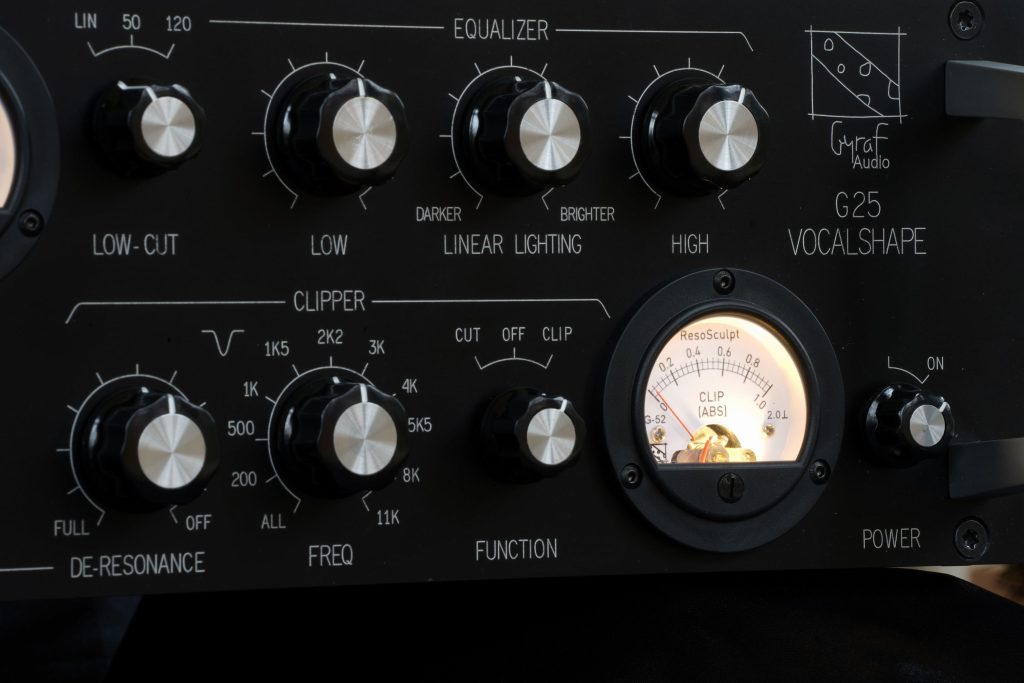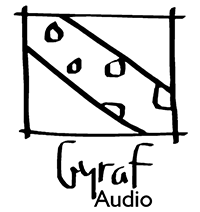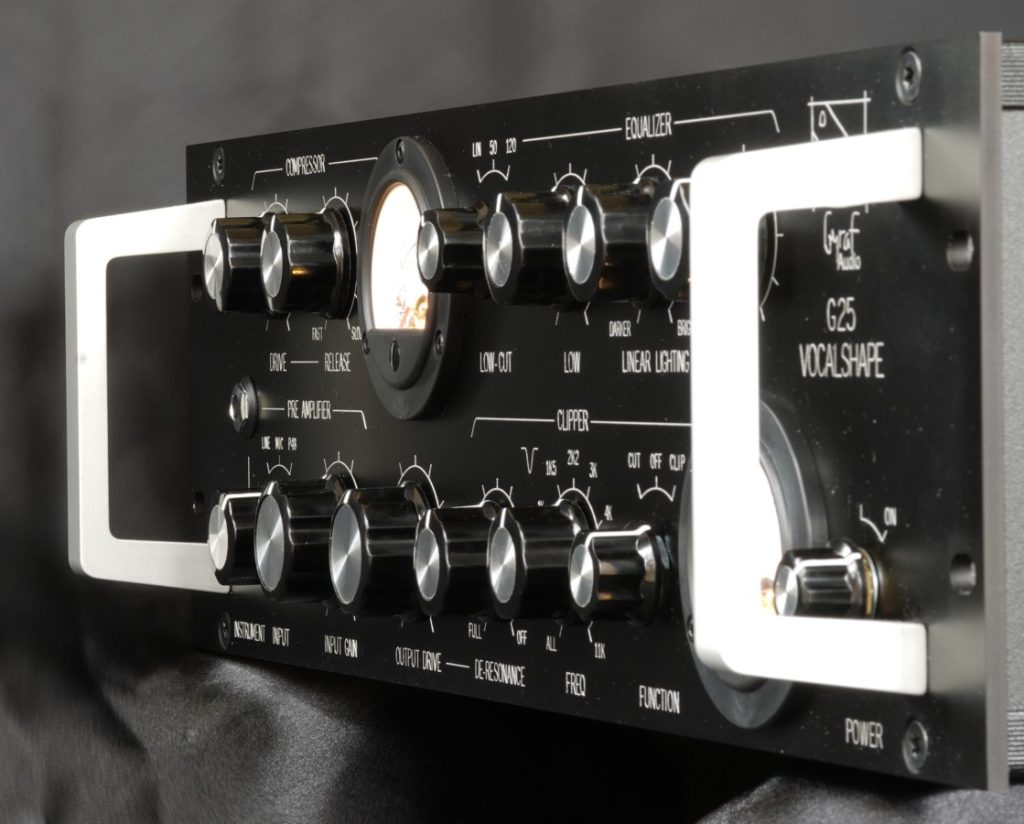Gyraf Audio G25 “VocalShape” voice recording preamplifier
The G25 “VocalShape” is our elaborate all-in-one box for vocal recording. It is an all-tube unit, consisting of a preamplifier stage, a filter and an equalizer section, a compressor, and finally a single stage of frequency-selective clipping for control of resonances. Every and all parameters optimized for – and only for – recording vocals.
First of all this is a tube device: All active functions, all amplification stages processing your signal are based on old-fashioned thermionic valves. This means that the unit usually will take 10-15 minutes from power-on before stabilizing into its working conditions. You can off course still use it during this time, but don’t expect too much precision or predict-ability before it’s settled.
So it’s a tube pre-amplifier, followed by a tube equalizer, feeding a vari-mu tube compressor, which in turn drives the output stage containing a single band of passive frequency-selective clipping.
All this packed in a 19″ 3u tall box…
What’s not to like?
Our mission with the G25
It all started some 15 years ago, a local mastering engineer whom I respect a lot ordered a G10 compressor for his setup. Then a couple of weeks later, he orders another one. Aargh, how do I explain to him in a nice way that he won’t ever need more than one of these, for any reason..?
His short answer was: “well, it’s not for myself – duh – but my wife’s a singer. She heard the G10 – and she has very good taste in compression for vocals..”
This was probably the beginning of me realizing that we’d have to get that compression in the hands of artists rather than engineers in some form or another. The Dual’ized version, the G22, was a step in this direction – but still somehow too excluding for anyone but studio techs due to it’s degree of over-engineering and the sheer bulk of it’s 3u 19″ size – just for the compression part of the chain.
Then some years ago one of our local studios were recording an album with above mentioned vocalist – and her vocal recording chain turned into a really tall stack of reserved hardware: Quite a few of the available Gyraf units ended up in permanent use there – but in particular the G21 “Magneto-Dynamic” frequency-selective clipper was shining in its newfound function of controlling voice resonances above a certain level. And the linear-transfer tilting knob of the G23 was just right more often than not.
This was the point of no return for Anders Boll, the engineer in charge of those sessions – he promptly started a campaign of persuading us into compacting that monstrous tower of a vocal setup into something manageable. Initial arguments were like: “..look at this attack-time control – we NEVER move that, no matter who’s singing.. Can’t we just get rid of that..?” and “..who the f* would ever need fine control over both threshold and ratio for when recording vocals?”
Turned out that when we followed this approach to its logical conclusion – optimized circuitry for vocal use only, we were able to put together a system that not only was much more compact than the original heap, but also profoundly more user friendly, almost intuitive, in its user-interface. This was the core G25 idea.
Now all that was left was trying out different hardware ideas and control-range optimizations – we’ve spent the last three years frequently consulting Anders and his visiting artists about functionality, interfacing and expectations for the system. Now here, late 2023, ca. 92 revisions later, we’ve had the resulting G25 in the hands of a small group of independent engineers and artists – and it turns out that now we finally have it ready to fly..
..and oh, by the way: – it turned out that even though we went out of our way to optimize for vocals and only for vocals, we still ended up with a box that does so much more. But that’s for you to discover when you have it in your hands one day.
Preamplifier
The topology of the G25 preamplifier is very much like our classic G9, in a version optimized for high-gain frame-grid tubes (6N23P/E88CC).
“INPUT” Switch selects between Line, Mic, and Mic+P48. The” GAIN” switch controls the amount of gain applied – ca. 4bB steps.
Mic/Line Inputs are floating transformer balanced, Line load is ca. 10K Ohms, Mic load ca. 2K Ohms. 48V Phantom power can be switched on only to the Mic input – for phantom powering condenser microphones that may need this.
The Instrument input jack on the front is a very-high-Z input that simply interrupts the connection to back panel Mic/Line connectors when a jack is inserted. The addition of this Instrument input was possible without in any way compromising the units usability for vocal recordings – it’s a left-over from early revisions that is kept in place because of popular demand – several of our test drivers insists on its qualities for processing certain instruments. Ymmw.
Mic gain maxes at a bit more than +70dB, plenty for your old beaten-up SM7, and happy with anything louder. Line gain is generally some 27dB under Mic gain setting, Instrument input gain some 17dB under mic. With all knobs set to 12 o’clock, we see some +48dB gain in mic mode, +21dB in line mode
Equalizer
Eq section consists of a first-order HPF @ 50Hz or 120Hz, a High/Low shelving symmetric boost/cut Bax at 6dB/Oct combined with the Linear Tilt circuit from our G23 – adjustable between +/- zero and one dB/Oct at its extremes.
Vari-mu Compressor
Copied from the G10, off course. Fixed ca. 20ms Attack, variable Release some 50ms-1.6sec . Threshold and Ratio functions are combined into one knob labeled unified “Drive”. Gain reduction read-out on meter.
De-resonance/Clipper
This stage, which is integrated into the unit’s output transformer – and thus comes after the “Output Drive” control pot, is our frequency-selective clipping circuit. The topology is a simplified version of the G21 Infundibulum – with a handful of switchable frequency ranges selected for their usefulness for helping vocal trouble. The “ALL” position is simple full-spectrum schottky diode clipping.
 The “Function” switch can bypass this stage or put it into one of two modes: In “CUT” mode, the circuit acts like a subtractive eq, allowing you to turn down parts of the spectrum. In CUT mode, the clip meter is not active. “CUT” is also a useful mode for finding the frequencies that you potentially want to deal away with. Now, if you find something annoying then put the “Function” into “CLIP”, the de-resonance stage will remove that part of your frequency range, but only when you are above a certain threshold, some set amount of build-up in that spectral area. In other words, you can home in and remove annoyances almost like a dynamic Eq. The “De-resonance” pot controls how much you activate this function – it both controls the threshold of onset of the clipping and the ratio of removal. As this function only subtracts, i.e. turn down signal, the knob logically goes from off/neutral at fully clockwise “turned up” to full-removal at counterclockwise “turned down”. Note that the “De-resonance” pot works in concert with the “Output Drive” – being placed at the output of the unit, reacting to the absolute output level, it’s dependent on both settings. The “CLIP” / “ResoSculpt” meter is indicating how much energy you are removing from your signal – but for technical reasons (it’s passive after all..) the readout is an absolute value, not a relative one like the dB GR-meter for the vari-mu compressor. This means that minor movement at lower levels may well indicate more relative “action” than a lot of movement at high operating levels. In other words, don’t get too focused on precise amounts of needle-movement here – unless you know your source and its operating levels well.
The “Function” switch can bypass this stage or put it into one of two modes: In “CUT” mode, the circuit acts like a subtractive eq, allowing you to turn down parts of the spectrum. In CUT mode, the clip meter is not active. “CUT” is also a useful mode for finding the frequencies that you potentially want to deal away with. Now, if you find something annoying then put the “Function” into “CLIP”, the de-resonance stage will remove that part of your frequency range, but only when you are above a certain threshold, some set amount of build-up in that spectral area. In other words, you can home in and remove annoyances almost like a dynamic Eq. The “De-resonance” pot controls how much you activate this function – it both controls the threshold of onset of the clipping and the ratio of removal. As this function only subtracts, i.e. turn down signal, the knob logically goes from off/neutral at fully clockwise “turned up” to full-removal at counterclockwise “turned down”. Note that the “De-resonance” pot works in concert with the “Output Drive” – being placed at the output of the unit, reacting to the absolute output level, it’s dependent on both settings. The “CLIP” / “ResoSculpt” meter is indicating how much energy you are removing from your signal – but for technical reasons (it’s passive after all..) the readout is an absolute value, not a relative one like the dB GR-meter for the vari-mu compressor. This means that minor movement at lower levels may well indicate more relative “action” than a lot of movement at high operating levels. In other words, don’t get too focused on precise amounts of needle-movement here – unless you know your source and its operating levels well.
Technical:
This preamplifier is built around a signal chain entirely based on tubes – we have chosen this because we think that some of the specific overload characteristics of tubes can be very beautiful when applied to certain types of voice performance and recordings. This means that we intend the unit to enable you to experiment with the less-than-clean border areas at high operating levels.
Output impedance is ca. 150 Ohms floating transformer balanced. This unit was originally made for use with our local recording studios, which means that we have optimized for “conservative” operating levels around +4dBu – at this point you still have some 14dB up to the point where the unit starts to sound really hot, which happens around 15Vpp AC output – and then some again before it starts sounding unusably bad.
This means, however, that you should consider checking your levels if you’re running a modern-day DAW, which often comes factory set to extremely-high levels like +24 or +28 for 0dBfsd. Those kinds of levels are aimed at keeping a good safety-margin before running into digital-clip, but at the same time it’s common practice (for a good reason) to try getting as close to clip as possible.
A good level for use with the G25 (and for most analogue gear in general) is somewhere around +10dBu to +15dBu analogue for 0dBfsd (full scale digital)
Tube types:
The G25 comes preloaded with four new-old-stock tubes:
Pre-amplifier and EQ stages are built around 6N23P tubes – one for each section. At this time (ser. no. ca. #001-050) these will be Russian military 1980’es production. Expected to last very long.
The vari-mu compression stage is built around a PCC189 (6ES7) – most probably a late-1960’es Philips, or a 1970’es Mullard. These can last ridiculously long too.
The output driver stage, which also feeds the frequency-selective clipping circuit, is based on a PCC88 – in this case made by Tesla in CZ before the world went insane, and should last probably as long as the vari-mu PCC189. “Probably” here because I’ve only used these for 7-8 years, and I haven’t yet had to replace one (!)
Contact Gyraf Audio for instructions on eventually replacing tubes when that time comes. Your local guitar amplifier repairman, if decently into tubes, could help with that also.
G25-A
The G25-A is a not-yet-finished specialized version intended as power supply and hardware extension for the legendary Campbell Transmitter “Astrud” tube microphone. The Astrud connects through an additional 7-pin XLRf connector located on back panel. Astrud will be available only on special order and by appointment with mr. Campbell. As of September ’24 we’re not yet decided on actual implementation, so don’t hold your breath.
Important notice:
Do not open this unit: When powered, there are high – potentially lethal – voltages present inside, including mains voltages. Refer servicing to qualified personnel.
You can safely remove the four rubber feet if you wish to mount this unit in a tight rack – please save the feet AND screws for future use, do NOT use longer screws than the supplied M3x6. NOTE: The feet are the ONLY part that can safely be removed. Do not loosen any other screws!
This unit operates from 220-230V AC, consumes about 34W, and the mains fuse is a 315mA slow-blow type. For the US-version, marked “CE 115VAC” above the power input connector, the operating voltage is 110-120VAC, and the fuse is a 630mA Slow-blow (“T”) type.
VIDEO LINKS:
Lars von Thienen made a couple of demo videos on the G25 – this one on the dynamics section, with audio example:
..and this one on the EQ curves (no audio):
A clip with youtube guru Warren Huart, on the G25’s Eq section:
(note that in this video there’s also a long’ish interview with Jakob Erland on general Gyraf units at 0-13min)


